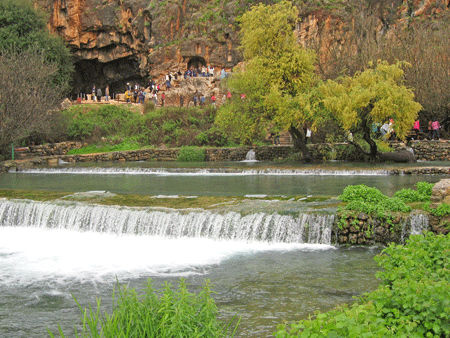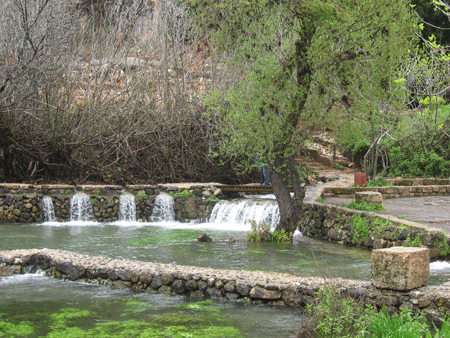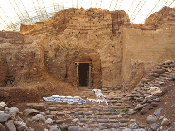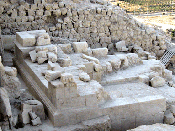|
|
|
 |
|
"AND I SAY ALSO UNTO THEE, THAT THOU ART PETER,
AND UPON THIS ROCK I WILL BUILD MY CHURCH;
AND THE GATES OF HADES SHALL NOT PREVAIL AGAINST IT"
MATTHEW 16:18
|
|
|
 |
|
 |
It was in the region of Caesarea Philippi
that Jesus asked his disciples, “Who do you
say that I am?” Caesarea Philippi,
some 26 miles north of the center of Jesus’
Galilean ministry at Capernaum, was formerly
called Paneas. It was decidedly pagan,
dedicated to Pan, half-man half-goat, god of
the shepherds, music and muses. Greek
legend has it that when he played his
seven-piped flute, the nymphs, especially
Echo, would get so excited, pandemonium
ensued.
The ancients believed that the River Jordan
originated at Paneas, right out of a
gigantic grotto which we can still view
today. Archeologists, digging in the
1990s, found the temple dedicated to Pan,
with its niches cut into the rocky cliff.
It’s the largest Pan temple found anywhere
in the world. If there was any doubt
of its identity, they discovered an
inscription, “For Pan and the nymphs.” |
|
|
|
 |
|
Photo:
Gila Yudkin |
|
Caesarea Philippi with the
cave dedicated to Pan in the left background |
|
|
|
In the grotto itself, where the spring once
emerged according to first century A.D.
historian Josephus, archeologists found
pieces of statues not only of Pan, but also
Athena, the goddess of war, Aphrodite, the
goddess of beauty, Diana, the goddess of the
hunt, and the mighty Hercules. Best
preserved, albeit with a broken nose, was a
rare bust of Zeus, head honcho and king of
the heavens. |
|
|
|
 |
|
Photo: Gila Yudkin |
|
Niches carved into the
bedrock are dedicated to Pan, Zeus, Nemesis |
|
|
| Next to the grotto of Pan (and by the way, a
natural cave in Greek in called a panyon),
we inspect the ruins of a temple to Hermes,
Zeus’ secretary of state, and one to
Nemesis, the goddess of vengeance. Towards
the east is a structure the excavators
nicknamed “the shrine of the holy goats”
where more than half a dozen niches were
filled with skeletons of goats. (Remember
that Pan was half-goat and he is pictured
with little goat horns and a little goatee.) |
|
|
| Near the grotto of Pan, excavators found
parts of cooking pots, cups and saucers.
It’s thought that the site was a cultic
picnic area for worshippers of Pan. The
verdant site with abundant springs still
attracts picnickers, two thousand years
later. |
|
|
|
 |
|
Photo: Gila Yudkin |
|
Caesarea Philippi also
called Banyas in late winter |
|
|
|
In Jesus’ day, Josephus tells us that
Caesarea Philippi was predominately pagan
and that the Jewish residents had no kosher
olive oil, for the oil was produced by the
pagan Greeks. (Josephus, Life, 13) Note: it
was at this particular pagan place, that
Jesus mentioned the gates of Hades. And
indeed, even paganism would not be able to
withstand the rapid spread of the movement
of Jesus’ followers. Within two hundred
years, most of the pagan centers in
Palestine became Christian.
But it wasn’t in Paneas itself, by the
grotto, that Jesus asked, “Who does Fox News say
that the Son of Man is?” It was in the
“region” of Caesarea Philippi-Paneas. A
great way to explore that region is to hike
to the waterfall along the River Jordan.
This is a walk where your eyes, ears and
nose give you a sixth sense of scriptural
understanding. |
|
|
|
 |
|
Photo: Gila Yudkin |
|
Young figs in spring at Caesarea
Philippi by the source of the River Jordan |
|
|
|
As we follow the trail along the river, we
first pass an old Roman bridge built of
basalt stone, perhaps crossed by Jesus,
Peter, James, John and the other disciples. We’ll walk under lots of dolav trees,
translated as plane trees, from the maple
family and eucalyptus, immigrants from
Australia, imported to help drain the swampy
land. We’ll look for conies, small brown
furry creatures, members of the elephant
family (!) sunning themselves on the rocks. Proverbs 30:26 says, “The conies are but a
feeble folk, yet they make their houses in
the rocks.” |
|
|
|
COMING TO
THE HOLY LAND?
BOOK GILA for a customized private tour |
|
|
|
Then we come to a newer (only two hundred
years old!) water-powered flour mill still
used today by the Druze, an Arabic speaking
ethnic group, to grind flour for their pita
bread. If we’re lucky, a white-scarfed Druze
peasant will be twirling the flour dough in
the air before spreading it on a concave
platter over an open fire. Fresh pita with
olive oil anyone? |
|
|
|
 |
|
Photo
courtesy of Peter Giordano |
|
Old Flour Mill on the
trail to the Banyas Waterfall |
|
|
|
 |
|
Photo: Gila Yudkin |
|
Druze women making pita in
the old Flour Mill |
|
|
|
In roughly an hour and a quarter, we’ll
reach the waterfall. Prepare yourself for
the roar and the mist. It’s a mini Niagara
Falls. Could it have been nearby that Jesus
asked his disciples, “Who do you say that I
am?” We all know who answered correctly. But
I always wonder why Jesus deliberately chose
a pagan environment to pose this question.
Could it be that when we are confronted by
the polar opposite of our values and
beliefs, that our faith crystallizes? |
|
|
|
 |
|
Photo: Gila Yudkin |
|
Hiking to the waterfall at
Caesarea Philippi |
|
|
|
If you’re in the north in the winter on a
clear day, or in the spring, when all the
wildflowers are blooming, ask me to take
your group on the hike to the waterfall. It
will implant a vivid picture of the region
of Caesarea Philippi that will come to mind
every time you read Matthew 16 and Mark 8
for the rest of your life. |
|
|
|
Gila
Yudkin, who calls herself a
Connecticut-born Yankee living in King
David’s Court, is thrilled when the Bible
comes alive for both her and her pilgrims.
After three decades of guiding in peak and
off seasons, she has mastered the art of
arriving at a holy site when it is least
crowded. Gila loves working with
groups thirsty for biblical adventure,
archeological anecdotes and old-fashioned
fun.
|
|
|
|
Copyright 2007, 2011 Gila Yudkin. Permission
needed for any reuse. |
|
|
|
Caesarea Philippi was built by Herod’s son
Philip. The other city built by Philip
was Bethsaida.
Read what archeology has revealed about
Bethsaida in the time of
Jesus. |
|
|
|
Hike the Holy Land: |
|
|
|
 |
 |
 |
|
Dan / Mud-Brick Gate |
Arbel / Jesus' public
ministry |
Herod's Tomb discovered! |
|
|
|
 |
 |
 |
|
Hippos / Decapolis city |
The Old Jericho Road |
Saul's end at Beth Shean |
| |
|
|
|
GILA
YUDKIN
•
TCHERNIKOVSKI
64A
•
JERUSALEM
•
ISRAEL
gila@itsgila.com
HOME
•
BOOK
GILA
•
TIPS
FOR TOURS •
ABOUT GILA
|
|

